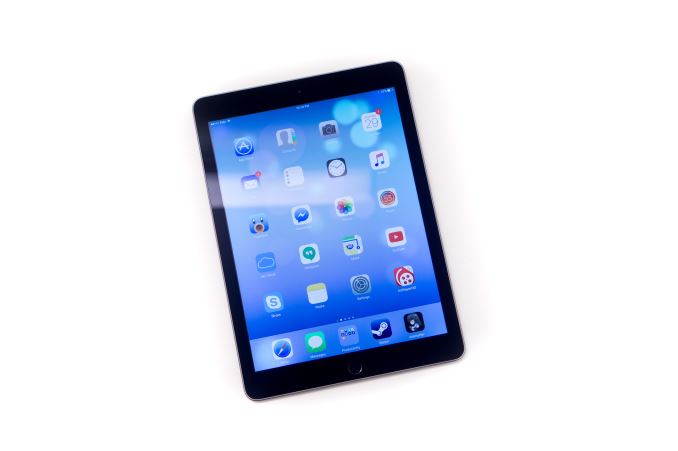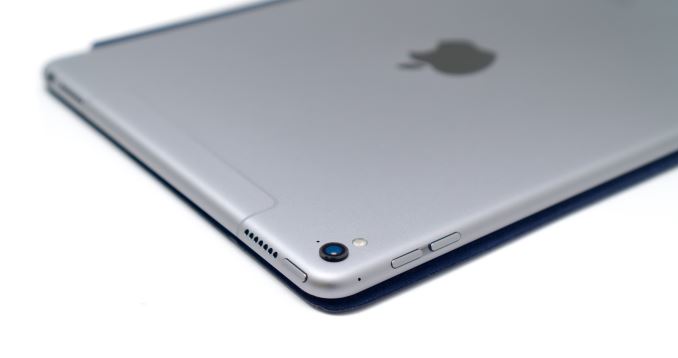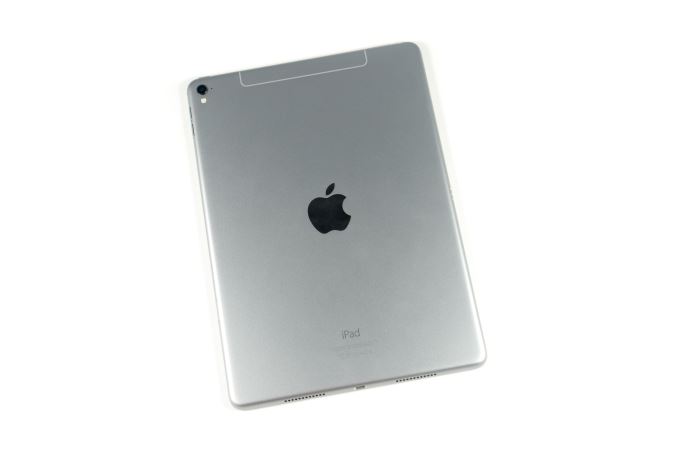The 9.7" iPad Pro Review
by Brandon Chester on June 1, 2016 9:00 AM EST
In late 2015 Apple launched a tablet that they called the iPad Pro. It had been rumored for quite some time, and it had a number of features that differentiated it from other iPads. The most notable was its 12.9" display, which has a width equal to the height of Apple's 9.7" iPads, allowing it to use two essentially full sized iPad applications at the same time in a split screen view. In addition to its massive display, the iPad Pro came with two accessories that had not existed for any prior iPad. It seemed that in Apple's eyes the Apple Pencil and the Smart Keyboard really defined what made the iPad Pro worthy of the "Pro" name.
Meanwhile, the launch of the iPad Pro came and went, and there was no news of a successor to Apple's iPad Air 2, which had just turned one year old. I thought that this move may have had to do with Apple not facing much competition in the tablet market. On the other hand, with iPad sales down it wouldn't generate much excitement to keep selling the same tablet for a second year.
After the launch of the iPad Pro the rumor mill continued to churn out new info, and there were whispers of a so called "iPad Air 3" coming in early 2016. Later, the story became that Apple was actually planning another iPad Pro to take the place of the iPad Air 2 as Apple's flagship 9.7" iPad. In the end it turned out that Apple did exactly that, and along with bringing the specs of the larger iPad Pro to a smaller size, the smaller iPad Pro comes with some surprises of its own. Below you can view the current state of the iPad line now that Apple has two devices called the iPad Pro.
| Apple iPad Family | |||
|
|
Apple iPad Air 2 | Apple iPad Pro 9.7" | Apple iPad Pro 12.9" |
| SoC | Apple A8X 3 x Apple Typhoon @ 1.5GHz |
Apple A9X 2 x Apple Twister @ ~2.2GHz |
Apple A9X 2 x Apple Twister @ ~2.2GHz |
| GPU | PowerVR 8 Cluster Series6XT | PowerVR 12 Cluster Series7XT | |
| RAM | 2GB LPDDR3 | 2GB LPDDR4 | 4GB LPDDR4 |
| NAND | 16/64/128 GB | WiFi: 32 / 128 / 256 GB | |
| WiFi + Cellular: 32 / 128 / 256 GB |
WiFi + Cellular: 128 / 256 GB |
||
| Display | 9.7" 2048x1536 IPS LCD | 12.9" 2732x2048 IPS LCD | |
| Gamut | sRGB | DCI-P3 | sRGB |
| Size and Mass | 240 x 169.5 x 6.1mm 437g WiFi, 444g LTE |
305.7 x 220.6 x 6.9 mm 713g WiFi, 723g LTE |
|
| Camera | 8MP Rear-facing f/2.4, 1.1 micron |
12MP Rear-facing f/2.2, 1.22 micron |
8MP Rear-facing f/2.4, 1.1 micron |
| 1.2MP Front-facing f/2.2 | 5MP Front-facing f/2.2 | 1.2MP Front-facing f/2.2 | |
| Battery | 27.3 Wh | 27.5 Wh | 38.5 Wh |
| Launch OS | iOS 8 | iOS 9 | |
| Cellular | Category 4 LTE + GPS/GNSS in Cellular SKU | ||
| Other Connectivity | 2x2 802.11a/b/g/n/ac + BT 4.2, Apple Lightning, Smart Connector on iPad Pro | ||
| SIM | Optional NanoSIM | ||
| Current Price |
16GB: $399 |
32 GB: $599 128 GB: $749 256 GB: $899 |
32 GB: $799 128 GB: $949 256 GB: $1079 (LTE) |
The 9.7” iPad Pro has the same core industrial design that Apple’s iPads have used since the launch of the iPad Air. The back is almost entirely flat, curving up quickly near the edges and meeting the cover glass with a shiny chamfered edge. Like the 12.9” model, the 9.7” iPad Pro changes things up by moving to a four-speaker audio setup, which requires holes drilled on both the top and bottom of the chassis. Interestingly, the 9.7” iPad Pro uses asymmetrical speaker grilles, with the bottom two being larger than those of the 12.9” model, and the top being smaller. This is likely due to the more constrained space inside the chassis. As for the speakers themselves, the audio quality did seem to be a step down from the larger iPad Pro, but it’s still miles ahead of anything else that I’ve seen on a tablet of this size and a significant improvement from the iPad Air 2.
The 9.7” iPad also comes with some changes of its own. The camera now has a hump, which will undoubtedly upset those who focus heavily on the uniformity of the design. There was no good way to improve upon the iPad Air 2’s camera within a 6.1mm chassis without putting a hump, and as we’ll see later, the camera in this iPad Pro is a huge improvement over Apple’s other iPads. While the hump is there, with such a large chassis the angle it makes with a flat surface is so small that the tablet doesn’t rock back and forth when using it on a table, which is extremely important to ensure the usability of the Apple Pencil.
Apple has also changed up the antenna design. Going back to the first iPads, the cellular models have sported a plastic RF window at the top of the chassis to allow for RF propagation. With the 9.7” iPad Pro, Apple adopts a similar antenna design to that of the iPhone 6 and 6s, where the top now has a metal segment for the antenna with insulating plastic lines surrounding it.
I think this is a significant upgrade to the design of the cellular model for a couple of reasons. Aesthetically it simply looks better, as the plastic inserts weren’t color matched and so they stood out from the rest of the aluminum back cover. They also weren’t always aligned perfectly, and so at the edge between the plastic and the aluminum you could feel a noticeable seam due to the plastic being either at a higher or lower level than the chassis. The new antenna design eliminates both of these issues, and brings the 9.7” iPad Pro as close as it can get to an unbroken aluminum unibody when also having to support cellular networking.
Beyond the changes with the camera, speakers, and antenna on the cellular model, the 9.7” iPad Pro has the same design as the iPad Air 2. They share the same mass and dimensions, and as I mentioned before the core ID is the same. Whether or not Apple could improve upon the design further is up for debate, but they don’t really have any true competition in this space and so they’ve been able to maintain their design lead by making iterative improvements on the original iPad Air design. That design still works very well, and so I don’t see much reason to change things up significantly just for the sake of saying you have a new design.












144 Comments
View All Comments
Shadowmaster625 - Wednesday, June 1, 2016 - link
So this thing really does outscore AMD's top end FX-9590 in kraken 1.1?bernstein - Wednesday, June 1, 2016 - link
very interesting! in other words: it's almost half the speed of intel's top end i7 6700K in kraken 1.1......but in WebXPRT it's 200 vs. 3000 points...
So what's the more realistic results?
bernstein - Wednesday, June 1, 2016 - link
i7 6700K: http://www.anandtech.com/show/9483/intel-skylake-r...tuxRoller - Wednesday, June 1, 2016 - link
That score of 3000 is..I don't know, but a 2015 xps 15 scores around 440.So, about twice as fast as the Apple soc, but with better process, higher power budget and much larger tdp (given that it's in a full size laptop).
Stoked
Apple's doing an amazing job with their cpus. If they actually spent the die budget to enable smt they'd be right up there with core m.
tuxRoller - Wednesday, June 1, 2016 - link
http://principledtechnologies.com/benchmarkxprt/we...michael2k - Wednesday, June 1, 2016 - link
More interesting to compare it to ahttp://www.anandtech.com/show/10000/who-controls-u...
Carrizo is essentially Atom class and it's predecessor, Kavari, is found inside the PS4 and XB1, albeit with a more powerful GPU and an additional 4 cores. So if you can imagine a 4W processor competing with a 65W CPU:
http://www.anandtech.com/show/10000/who-controls-u...
That leaves about 50W for Apple to integrate, say, a Pascal GPU if they really wanted to create something incredibly powerful.
mdriftmeyer - Wednesday, June 1, 2016 - link
You are high if you compare a 4 core Excavator to an Atom.255BB - Thursday, June 2, 2016 - link
PS4 and Xbox one use Kabini not Kaveri. A 4 cores Kabini has a 15W TDP.Carrizo is not an Atom class .Its TDP is 15-35W (Carrizo-L is Atom class)
Meteor2 - Thursday, June 2, 2016 - link
Perhaps the same *performance* class. Not power class.michael2k - Thursday, June 2, 2016 - link
Right. So take a 4W SoC that currently has two cores and bump it up to 8. An A9X at 2GHz and 8 cores might take 15W. Throw in a Pascal GPU and now you're 35W, or 65W, depending on compute cores.On single thread performance we see the A9 is between Atom and Core at the same clock. That means it is also at the same performance level as Kaveri and Kabini.